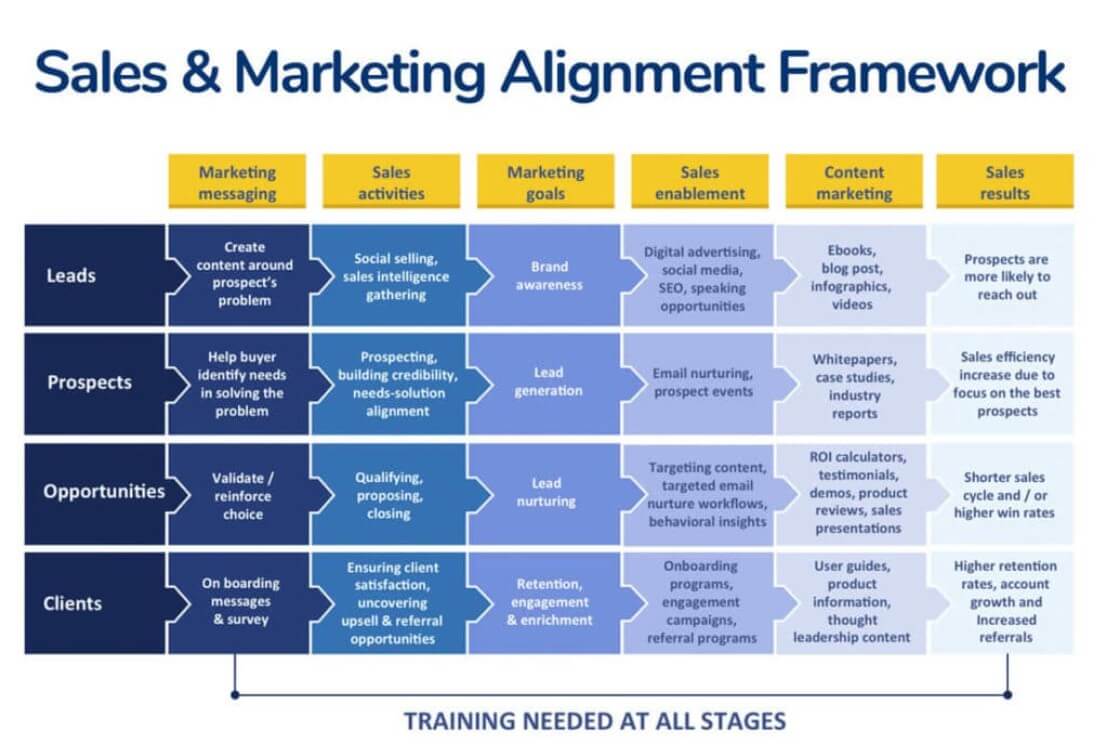This blog post will delve into the significance of sales and marketing alignment in achieving business success and explore ways to foster better collaboration between these two critical functions. So buckle up and read on to discover why sales and marketing alignment is essential for businesses of all sizes.
Introduction to Sales and Marketing Alignment
Sales and marketing alignment, also known as smarketing, is crucial to any successful business. As highlighted in the previous sections, when sales and marketing teams work together, they can boost company revenue, improve productivity, and deliver a better customer experience. Sales and marketing alignment involves creating a unified framework of goals and strategies that enables both teams to work harmoniously.
This ensures that marketing messages align with the buyer’s needs while the sales team reinforces those same messages to warm up prospects and close deals faster. By establishing clear and consistent communication and sharing information, sales and marketing teams can work collaboratively to streamline the buying experience, win more deals and improve business performance.

Collaborative Environment for Better Results
Collaboration is key to achieving success in the sales and marketing world. In a collaborative environment, sales and marketing teams work together to achieve common goals, develop shared strategies, and share information openly. This approach fosters better cross-functional collaboration, enhances communication, and drives revenue growth. By working together, sales teams have a better understanding of marketing offerings and can more easily vet leads, while marketing teams create content that directly caters to the needs of the customer.
Collaboration is an important aspect of the sales and marketing alignment process and ultimately leads to better results for the business as a whole.

Faster Deal Closures with Sales and Marketing Alignment
With a collaborative and aligned sales and marketing team, the process of closing deals becomes faster and more efficient. By working together to identify high-quality leads and nurturing them with targeted messaging and engagement, sales can close deals more quickly and with less friction. When marketing and sales strategies align, prospects are warmed up effectively, and reinforced messaging ensures that they feel confident about their purchase decisions.
This seamless buying experience contributes to higher conversion rates and shorter sales cycles. By achieving sales and marketing alignment, businesses can unlock the potential for faster deal closures and overall business growth.

Understanding Buyer Needs to Win More Deals
Understanding the needs of the buyer is the key to winning more deals, and sales and marketing alignment is critical in achieving this outcome. When sales and marketing teams are synced up, they better understand the customer and the buying process. This allows them to tailor their approach to meet the needs of individual customers and present their products in a way that resonates with them.
By focusing on the buyer’s needs rather than highlighting product features, sales teams can build better relationships with customers and ultimately close deals faster. This collaborative approach, enabled by sales and marketing alignment, can lead to increased ROI, better customer retention rates, and, ultimately, business success.

Streamlining Buying Experience for Customers
Streamlining the buying experience for customers is a critical component of sales and marketing alignment. By understanding the buyer’s journey and tailoring strategies to meet their needs, organizations can create a seamless and enjoyable experience that ultimately leads to higher conversions and customer retention rates.
In addition to using marketing research to develop detailed personas and segments, sales and marketing teams can work together to warm up prospects and reinforce messages, providing a consistent and enjoyable experience from start to finish. By ensuring clear and consistent communication, teams can create a shared framework of goals and strategies that enable them to work with better efficiency and ultimately improve business performance.
With a focus on creating a buying experience that lands customers and impacts revenue, sales, and marketing, alignment is not just important, it’s essential.
Warming Up Prospects and Reinforcing Messages
Warming up prospects and reinforcing messages is critical to sales and marketing alignment. With both teams working together, marketing messages become more customer-focused and data-driven, resulting in higher content adoption rates. When the sales team forges strong relationships with prospects, they can provide valuable feedback to the marketing team, which can guide them in tweaking the customer profile and marketing content to better meet customer needs.
By aligning both teams, marketing messages can now warm up the prospects ready for the sales team, who will reinforce those same messages, increasing the likelihood of closing deals. A collaborative environment fosters a positive work environment where both teams share common pain points or objections that are brought up during sales conversations. This helps the marketing team to develop effective solutions that align with customer needs, resulting in higher conversions and revenue growth for the business.
Clear and consistent communication and shared goals and strategies create a symbiotic relationship between the sales and marketing teams, enabling better efficiency and improving business performance.
Clear and Consistent Communication
Clear and consistent communication between sales and marketing teams is essential for successful alignment. Sales and marketing teams must speak the same language, use aligned terminology, and consistently reinforce common messages. This assures a complete and accurate understanding of the buyer’s needs, preferences, and pain points. Such consistent communication helps teams focus on the same goals and strategies to improve efficiency, simplify workflow, and streamline the customer buying experience.
With coordinated sales and marketing efforts, businesses can provide a better buyer experience, ultimately driving revenue growth. With clear and consistent communication between sales and marketing teams, businesses can avoid confusion, inconsistency, and a slower sales cycle. Therefore, creating a collaborative environment that encourages transparent communication, active listening, and continuous feedback is vital.

Shared Framework of Goals and Strategies
Creating a shared framework of goals and strategies is crucial to sales and marketing alignment. This framework provides a clear understanding of the company’s objectives and how both teams can work towards achieving them. By establishing common goals and strategies, both teams can develop a more targeted and effective approach to their work, resulting in better outcomes.
With a shared framework in place, marketing can focus on campaigns and content that align with the sales team’s targets, while sales can better understand the value and purpose of the marketing materials they use. Overall, a shared framework helps align the entire organization around a shared mission and strengthens the collaborative relationship between sales and marketing.

Enabling Teams to Work with Better Efficiency
With sales and marketing alignment, teams can work with better efficiency than before. Streamlining internal processes and clarifying roles and responsibilities can eliminate redundant efforts and avoid duplicating tasks. This leads to a more focused approach to lead generation, customer engagement, and sales follow-up.
Clear communication channels and shared metrics also help teams identify gaps in their sales funnel and address them promptly. As a result, sales cycles become shorter, conversion rates improve, and customer satisfaction increases. With fewer barriers and more productive teamwork, the potential for revenue growth is exponential. Sales and marketing alignment is truly a winning strategy for any company looking to boost its bottom line.
Improving Business Performance with Sales and Marketing Alignment
The benefits of sales and marketing alignment are not only limited to better collaboration and faster deal closures. In fact, it has the potential to significantly improve business performance. By aligning both teams’ goals, strategies, and key performance indicators, they can work more efficiently and effectively toward achieving the same objectives. This can lead to increased revenue growth, stronger lead conversion rates, and a better buying experience for customers.
With clear and consistent communication, sales and marketing can better understand buyer needs and reinforce messaging to warm up prospects. By enabling teams to work with better efficiency, they can focus on high-value activities and ultimately drive business success. Overall, sales and marketing alignment is crucial in improving business performance and should be noticed.
Conclusion
In conclusion, sales and marketing alignment is more than just another buzzword in the business world. It is a vital concept that can lead to a significant improvement in business performance. By fostering a collaborative environment, both teams can work together to streamline the buying experience for customers and warm up prospects. A clear and consistent communication framework can help reinforce messaging and accelerate deal closures. The shared goal and strategy framework enable both teams to work with better efficiency and drive revenue growth.
Companies that prioritize sales and marketing alignment can reap the benefits of improved lead conversion rates and better customer experiences. So, it is high time for businesses to invest in sales and marketing alignment and foster a culture of collaboration that drives performance and revenue growth.
Frequently Asked Questions (FAQs)
What is the alignment between marketing and sales?
Alignment between marketing and sales refers to the synchronization and collaboration of these two departments within a company. It involves aligning their goals, strategies, and activities to work towards a common objective of driving growth, revenue, and customer satisfaction.
Why is sales and marketing aligning around serving customers so important?
Aligning sales and marketing around serving customers is crucial because it ensures a seamless and consistent customer experience. When both teams work together, they can better understand customer needs, preferences, and pain points. This alignment enables them to create targeted messaging, personalized offerings, and a cohesive buying journey, ultimately leading to higher customer satisfaction and increased business success.
What is the importance of sales and marketing relationships in business?
The sales and marketing relationship is vital for business success. Marketing generates leads, builds brand awareness, and creates customer interest, while sales converts those leads into paying customers. By fostering a strong relationship between sales and marketing, organizations can streamline the customer acquisition process, improve communication, enhance lead quality, and maximize revenue generation.
How do marketing and sales relate to one another?
Marketing and sales are interconnected functions within an organization that work together to drive business growth. Marketing generates leads, builds brand awareness, and creates demand for products or services. Sales, on the other hand, focuses on converting those leads into customers and closing deals. The relationship between marketing and sales is symbiotic, as marketing provides the foundation for sales success, and sales provides valuable feedback and insights to refine marketing strategies.
Why do sales and marketing work together?
Sales and marketing must work together to create a cohesive and effective customer journey. Marketing lays the groundwork by generating awareness and interest, while sales leverages those efforts to build relationships, address customer needs, and close deals. By collaborating and aligning their efforts, sales and marketing teams can deliver consistent messaging, provide a seamless buying experience, and maximize revenue potential.



